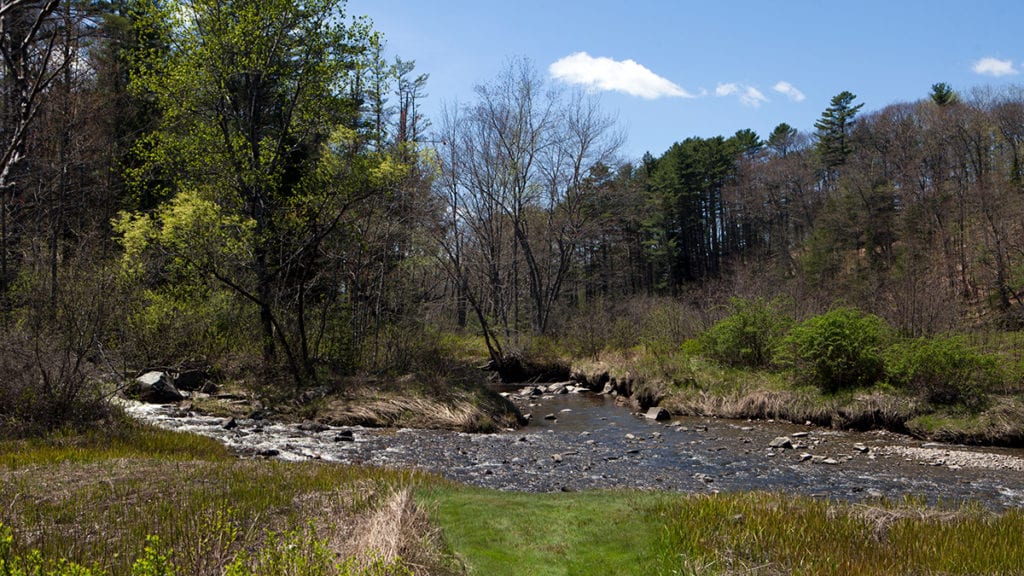
Only one mile from the bustling downtown of Freeport, Maine, Mast Landing is 145 acres of diverse habitat rich in human and natural history. It is located along the Harraseeket River estuary, with more than three miles of trails that wind along a stream and tidal marsh and through orchard, fields, and forest.
Maine Audubon sanctuaries are free and open to the public year round, dawn to dusk. Dogs, even while leashed, are not allowed in our wildlife sanctuaries, as their presence can be disruptive to wildlife. For our core policies for visiting a Maine Audubon sanctuary please read the guidelines here >
Nov. 8, 2022: Mast Landing fire damage minimal thanks to local crews
Directions
Mast Landing Audubon Sanctuary
65 Upper Mast Landing Road
Freeport ME
From I-295:
- Take exit 22 to merge onto ME-125 S/ME-136 S/Mallet Dr toward Freeport
- Turn right onto Main St
- In about .2 mile turn left onto Bow St
- After about 1 mile turn left onto Upper Mast Landing Rd
- The turn-in is about .2 mile up the road on your right. Parking is to the left.
Trails
Download the Mast Landing Trail Guide/Map (pdf)
View the Mast Landing trail map on Maine Trail Finder.
More than three miles of trails wind along a stream and tidal marsh and through orchard, fields, and forest. Well-used by visitors, they are ideal for hiking and cross-country skiing.
Ridge Trail (1.6 miles): Access all sanctuary trails from the Ridge Trail, which begins at the kiosk in the parking lot. The Ridge Trail winds through most types of habitat in the sanctuary, as well as past an old dam and mill site and the historic mill-master’s house.
Orchard and Deer Run Trails (0.5 miles): The Orchard Trail branches from the Ridge Trail soon after the Ridge Trail entrance at the parking lot. It leads to the Deer Run Trail, which rejoins the Ridge Trail. These trails pass through orchard, former farm fields, and mixed coniferous forest of pine, hemlock, and fir.
Mill Stream Trail (0.3 miles): Branching off from the Ridge Trail/service road at the dam site 0.3 miles southeast of the parking lot, the Mill Stream Trail follows the stream through riparian (river) habitat and overlooks the maple swamp before meeting back up with the Ridge Trail.
Estuary Trail (0.4 miles): Beginning and ending at the Ridge Trail/service road, the Estuary Trail, which is steep in places, takes you through field-grown white pines to the point overlooking the estuary.
Wildlife & Habitat
Mast Landing Audubon Sanctuary features open fields, apple orchards, alder lowland, and mature white pine and hemlock forest. Mill Stream flows past a historic dam and mill site before flowing into the tidal waters of the Harraseeket River. The sanctuary attracts migrant shorebirds and songbirds. In the springtime, it is a wonderful place to observe the courtship flight displays of American Woodcocks. Resident mammals typical of southern Maine woodlands include American Mink, Snowshoe Hare, North American Porcupine, Northern Raccoon, White-tailed Deer, and Coyote.
Allowable Uses
Mast Landing Audubon Sanctuary is both a wildlife sanctuary and conserved land. These rules and regulations have been adopted to allow for appropriate use of the land by the public, while protecting the land in its natural state to serve as a wildlife refuge.
Mast Landing Audubon Sanctuary is open from sunrise to sunset; the sanctuary is closed from sunset to sunrise. To protect wildlife and the natural environment at Mast Landing Audubon Sanctuary, the following activities are not permitted:
- No dogs or other pets (except service animals for people with disabilities)
- No motorized vehicles or bicycles on the trails or open spaces (exception for motorized wheelchairs or related equipment needed by individuals with disabilities)
- No fires, barbecues, cook stoves, fireworks, or smoking
- No firearms or hunting; no trapping
- No camping or overnight use
Click here for a complete list of restricted uses and allowable uses at Mast Landing.
History
The name “Mast Landing” dates to the early 1700s when the British navy sought ship masts made from massive white pines then common to southern Maine forests. Loggers hauled to a nearby ship landing the trees they felled and trimmed on what is now sanctuary land.
The sanctuary’s Mill Stream once powered a saw mill, a textile mill, two grist mills, and a woodworking shop. Destroyed by fire in the early 1860s, the mills and shop were not rebuilt, and their foundations are visible where Mill Stream flows into the estuary. In 1795, mill master Abner Dennison built the house that still overlooks the stream and estuary, and is a private residence for sanctuary caretakers. Up until the middle of the twentieth century, stock grazed on cleared land within the sanctuary, much of which has since reverted to forest.
In 1967, Maine Audubon founded Mast Landing Audubon Sanctuary on land donated by the L.M.C. Smith family. The family’s commitment to conservation helped protect much of Freeport’s shore land.
